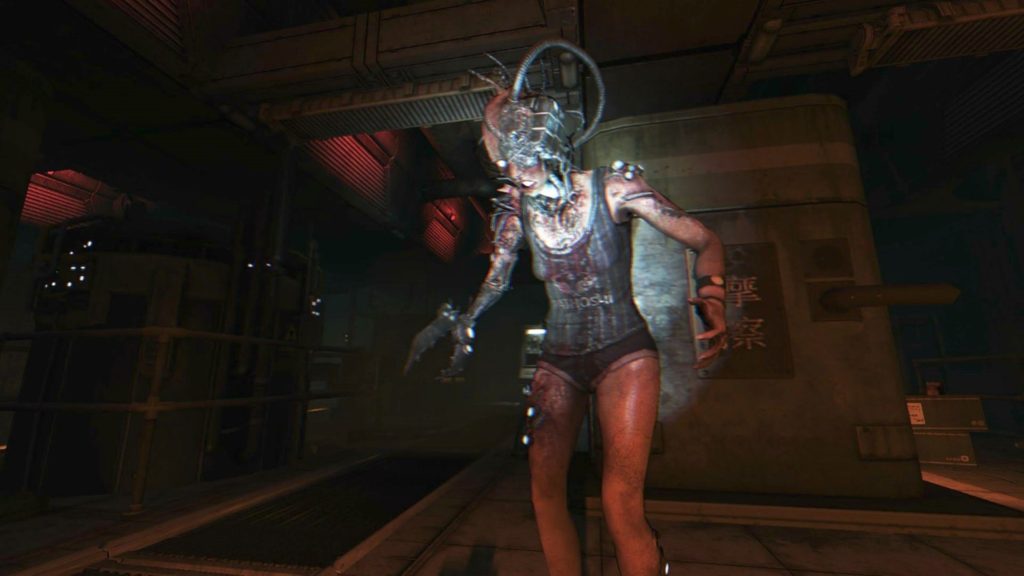Heavy spoilers for SOMA. Light spoilers for Watchmen.
When I finished SOMA, my jaw was on the floor. The game left me with a feeling similar to a great movie, leaving me sitting wide eyed in awe, looking at the credits, knowing that I’ll be thinking about the story in the weeks to come.
This may be why I was surprised to see that online reviews were a little mixed.
These reviews, however, didn’t say much that I disagreed with – they lavished praise upon the game’s story and the questions about human nature. Instead, their criticisms focused squarely on SOMA’s gameplay – trite puzzles (with the exception of a few which tie into its existentialist narrative), and overly forgiving monster segments which many didn’t consider properly scary.

Essentially, I would say that the common consensus on SOMA is that, though its gameplay is lackluster, its story is genius. But with this notion comes the implication that this game might be held back by its status as, well, a video game – after all, games are the only form of media that have gameplay.
So, would SOMA be better as a non-game?
Let’s think about that. Setting aside more unconventional forms of storytelling media (audiodrama, concept album, stageplay – though an experimental SOMA Broadway show would kick ass in a backwards kind of way), I want to look at some possible forms this could take, and rank them, analyzing if they would truly elevate SOMA beyond its game-qualities.
3 – Comic
This designation may make one wonder why I would consider comics to be one of the dominant forms of storytelling media, and to that I would answer I love comics, and I love making them too, so I am biased. Very biased.
Then, you may ask: if you love them so much, why would you think SOMA would be worst as a comic?
My answer would be that comics, in my mind, need a very specific type of story (this is why I feel like book-to-graphic-novel adaptations always leave a little to be desired), and are best when they take advantage of the medium to great effect. Let’s look at this panel sequence from Watchmen:

Look at the posing of the characters! The flow of motion! The spacing (look at that big golden V in the middle!)! The panel sizing, and how that imbues meaning into the scene!
Even removed from all context, one can tell that this scene could not have the same effect when removed from the medium – certain details will be missed, and one could not use frozen-in-time effects like perfectly shaped blood splatters or bullet ricochets to add this feeling of intensity.
This isn’t to say that comics are the only mediums with unique factors, but instead to say that what makes comics comics is hyper-specific, and SOMA really doesn’t have that. Further, a large part of SOMA’s narrative is the concept of switching perspectives, but in comics, switching perspectives is always happening as one moves from panel-to-panel, with nary a way to make it feel special.
2 – Book
It may also be weird to see this medium out of the #1 spot, because I would really love to read SOMA as a book. It’s dialogue sequences and creeping realizations would be an absolute delight to read in the dead of night, knowing that you will lie awake tossing those words around in your head. Just read this sequence, which I have tried to convert into book-form:
“You know, I woke up in my bed today, it just so happens to have been 100 years ago.” I said, and stopped dead in my tracks. I was somehow perplexed by something I said myself.
“Sounds like a riddle.” Catherine’s voice buzzed back over the Tool Chip. It broke my trance.
“Yeah. You’re right: I woke up in my bed today, a hundred years ago — Who am I?”
I breathed.
“…Who am I?”
(Grip, 2015)
Set aside my haphazard attmepts to bookify this video game, and look at this dialogue, and how it feels. To me, SOMA could easily be one of mindbending sci-fi paperbacks you would pleasantly unearth in a library. However, it is these parts of SOMA – the dialogue, and internal questioning – that would be the only ones that could easily make the transition.
What about the monster subplot, and the body horror? Or the puzzles? These segments make up a large part of the game, but would be dreadful to read. Book horror is very different than game horror, and SOMA’s traditional horror elements (setting aside its more complex existentialist ones) are as about as gamey as they can get.
So, one would have to change SOMA, cutting bits out as they please, into a purely existentialist work, to get it to function properly as a book. And that is why I wouldn’t give it the #1 spot.
1 – Movie
To me, SOMA as a movie is a simple and obvious choice. Both the existentialist questioning and action-horror sequences would fit great on the silver screen, and I could easily see SOMA becoming the first critically acclaimed game adaptation. Some omissions should be made for runtime reasons, but it could work.
And yet, despite all of this, I still feel like SOMA is best as a game. Why? Because, as bad as its gameplay might be, being a game fits the work’s theme best.
See, SOMA has to do with perspectives, and what it means to be human. Is your ‘copy’ a human? Would you jump to their perspective if one was ever made? Should you be justified in killing your original self-post copying?

These choices work best with both game perspective and agency. The moment in SOMA where you make a copy of yourself and jump to the copy’s first person perspective (promptly seeing your old self still confused, strapped to a chair), or have to use your own agency to kill a human consciousness copied into a robot body for their scrap, are hyper-specific to games.
And I think these moments are fascinating. Fascinating enough, at least, to deal with some supposedly bad gameplay.
Works Cited
Moore, Alan, et al. Watchmen. Dc Comics, 1987.
SOMA. Directed by Thomas Grip, 2015.

Hey AlgebraFalcon, I totally agree with your analysis on why ultimately Soma is best told through the video game medium. There’s something about living through Simon’s experiences, on finding things out as he does, on the power of visual impact and interactivity that is necessary to get at the core themes of Soma.
During play, especially in first person perspectives, it is easy to forget about the vessel that is your character’s body behind the screen. It’s something we don’t really think about, yet cannot deny the existence of. This is much like how Simon interfaces with his new body as well; there’s a gnawing sensation that something might be wrong, but hey, out of sight out of mind right? However, as the story progresses and he is forced to have more conversations about his new existence as a robot, there begins to develop an dreadful curiousity to what the reality of his situation is. This culminates in the mirror cutscene that the player can choose to view or not view; where Simon and the player sees for the first time how physically inhuman he has become. The impact of this visual would never have worked in a traditional visual mediums like comics or film, and reading already leaves too much room for subjective thought on how Simon or the setting appears. Only through gameplay and “forced” perspective do I think players are able to get the most out of Soma’s narrative.
I am so glad you brought this up, I’ve been thinking about this all while I played the game. Because….there is a comic book very much like it! (Albeit with a slightly different take and message). It’s called Upgrade Soul by Ezra Clayton. While I completely agree that Simon’s story is best told within a game, I do think it’s interesting because I was playing the game with this comparison in mind. In Upgrade Soul, an aging couple decides to take part in an experimental medical procedure that would give them back their youth. However, they realize the plan was never for them to become youthful again, but instead they were cloned with the intent for their original selves being disposed of, obsolete. A mistake is made, and both the clones and the originals are kept alive. The longer the clones survive, the quicker it kills the original copies. The clones have their exact memories, but the longer they stay alive, it’s apparent that they are vastly different from the original people they stem from, even though they should be the exact same. The clone of the husband falls in love with someone else, and the clone of the wife gives her life for her counterpart, knowing she shouldn’t be there. It raises a lot of the same as SOMA, especially with being replaced by something that is “yourself” without really being you, and the notion of being left behind.
The comic has a slow build and very little action. And, while having unsettling moments (and explorations of the uncanny) it is not a horror comic. Upgrade Soul takes advantage of the comic medium through its use of colors, strategic camera angles, and medium-specific elements like word bubbles and font. I think I would disagree that the story of SOMA is unfit for a comic. However, I believe the atmospheric elements of horror, the agency you mention, and the interactivity are medium-specific to games and enhance Simon’s story in a way comics or other mediums can’t.